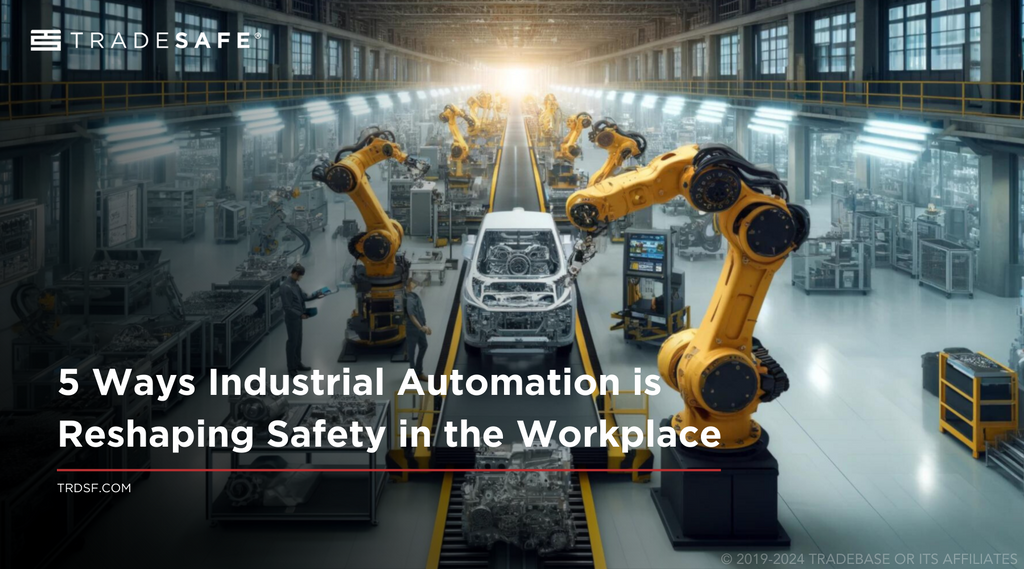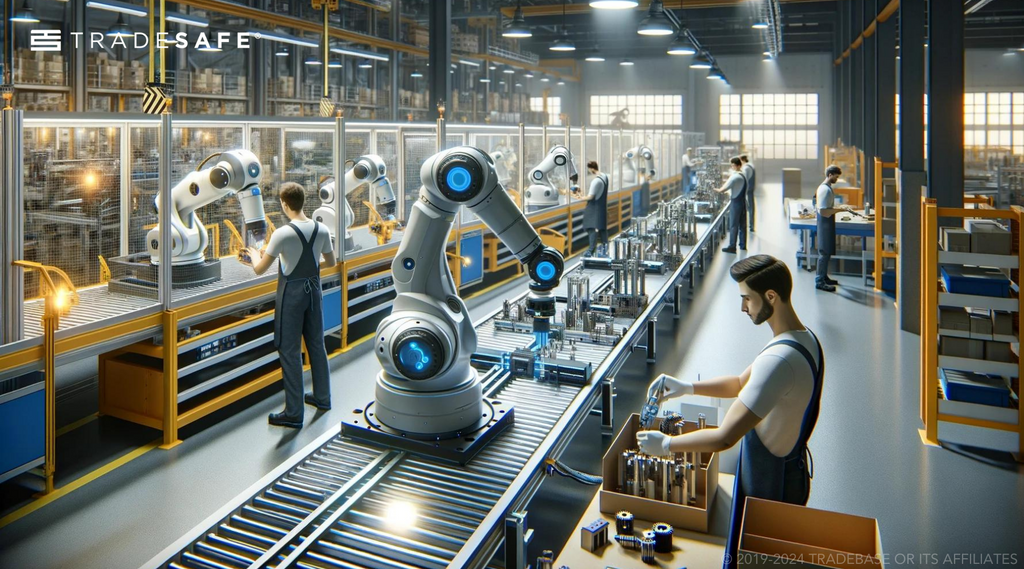
The industrial landscape is undergoing a transformation driven by automation and artificial intelligence. While traditionally associated with increased productivity and efficiency, automation is also revolutionizing safety practices across various industries. Historically, human labor often meant higher risks of accidents and injuries. This article explores five ways industrial automation is creating safer work environments for employees.
Are Skilled Workers Being Displaced by Automation?
There's a growing concern that automation could replace human jobs, particularly in sectors like the manufacturing plant, food service, and retail. These sectors are considered the most vulnerable according to a McKinsey Global Institute report. While it's true that automation displaces certain roles, the most significant impact of industrial automation extends beyond job loss.
According to a study, automation is expected to lower real wages for medium-skilled workers and low-skilled workers by diminishing the demand for these job types. This trend can widen the gap between workers who can adapt to new technologies and those whose skills become less valued due to automation in the workplace.
However, it's also crucial to recognize that workplace automation can shift workers to more complex and engaging tasks. By taking over repetitive and tedious responsibilities, it allows workers to focus on areas that require human insight and decision-making, thus enhancing job quality and automation safety in the workplace. This shift necessitates a strong emphasis on education and training to equip workers with the skills needed to thrive in a new, automated industrial environment.
4 Types of Automation
Automation in the industrial sector is not one-size-fits-all; it varies greatly to adapt to different operational needs. Here’s a look at the four main types of automation and how each of the new systems contributes to enhancing health and safety in workplaces:
Fixed Automation
Fixed automation involves automated machinery designed to perform one specific task. These systems are typically found in high-volume production settings like automotive assembly lines. The use of fixed automation ensures consistent and precise execution, which minimizes errors and enhances automation safety by limiting human interaction with potentially dangerous machinery.
Programmable Automation
Programmable automation systems are capable of being reprogrammed to handle different tasks or product designs. This flexibility is essential in environments like the electronics manufacturing plant, where production models frequently change. Programmable systems reduce the need for manual reconfiguration, thereby lowering the potential risk of accidents and ensuring safer transitions between tasks.
Flexible Automation
Flexible automation systems offer businesses the ability to switch between tasks quickly with minimal setup time. This type of automation is crucial in industries such as consumer goods, where a production line must adapt to different products. By automating the changeover process, flexible systems reduce downtime and human errors, ensuring a safer and more efficient operation.
Integrated Automation
Integrated automation involves a comprehensive system that controls multiple interconnected processes. This integration is often seen in chemical plants or refineries where health and safety are highly prioritized. By centralizing control and utilizing real-time data across various points, integrated systems enhance monitoring and response capabilities, significantly improving overall automation safety and efficiency.
5 Ways Automation Enhances Safety

Automation not only streamlines the production line but also significantly enhances health and safety in the workplace. Here are five key ways through which automation contributes to safer work environments:
Reducing Human Error in Repetitive Tasks
Repetitive tasks, especially those that require precision and consistency over long periods, are prone to errors when performed by humans. Factors such as fatigue, loss of concentration, or even simple misjudgments can lead to significant safety hazards.
For example, in a high-volume manufacturing industry where approximately 370,000 injuries are reported, even a minor error can result in defects that compromise product safety or lead to machinery malfunctions. Automation eliminates these risks by performing tasks the same way every time, ensuring high levels of accuracy and consistency.
Taking on High-Risk Activities
Certain jobs are inherently dangerous, involving exposure to hazardous conditions such as high temperatures, toxic substances, or explosive materials. Automation allows robots and systems to take on these high-risk activities, such as bomb disposal or chemical processing. By handling these tasks, automation protects human workers from direct exposure to dangerous environments, significantly reducing the risk of injury.
Research involving detailed establishment-level data from OSHA and ODI from 2005 to 2011 shows a clear correlation between robot adoption and a reduction in work injuries. The study found that an increase of one standard deviation in robot exposure (equivalent to 1.34 robots per 1000 workers) was associated with a reduction of approximately 1.2 injuries per 100 full-time workers. This reduction translates into significant cost savings—estimated at $1.69 billion per year (in 2007 dollars) in injury-related costs.
Improved Worksite Monitoring and Alerting
Advanced automation systems integrate sensors and monitoring tools that continuously assess workplace conditions. For example, sensors can detect toxic gas leaks, extreme temperatures, or mechanical failures. These systems can then automatically alert workers and shut down equipment if necessary, preventing accidents before they happen. Industries like mining and petrochemicals benefit greatly from such automated monitoring, enhancing workplace safety by providing early warnings and swift responses to potential hazards.
Enhanced Data Analysis and Predictive Maintenance
Automation enables the collection and analysis of vast amounts of data from equipment and environmental sensors. Through sophisticated algorithms, these systems can predict when a machine is likely to fail or when automation safety measures need updating. This aspect of automation, known as predictive maintenance, allows companies to address potential issues before they lead to equipment breakdowns or unsafe conditions, thus less costs, minimizing unplanned downtime, and enhancing safety.
Promoting Collaborative Work Environments
The rise of collaborative robots, or cobots, has ushered in a new era of human-machine collaboration. Cobots are designed to work alongside human workers, taking over physically strenuous, repetitive, or hazardous tasks. This not only reduces the physical strain on human workers but also enhances safety by delegating risky tasks to machines designed to perform them safely.
Cobots can be found in various industries, helping with automated material handling, specifically, lifting heavy objects, assembling products, or handling precise components, thus ensuring both efficiency and automation safety in the workplace.
Challenges of Automation in Workplace Safety
While automation significantly enhances health and safety in the workplace, it also introduces several challenges that need careful management to ensure these benefits are fully realized. The following points highlight the primary concerns associated with the implementation of automation technologies:
- High Initial Investment Costs: Implementing automation technology often requires a substantial initial investment. This includes not only the cost of the autonomous robots and artificial intelligence themselves but also the infrastructure needed to support them, such as advanced software and reliable hardware.
- Cybersecurity Risks: As workplaces become more interconnected with the inclusion of IoT (Internet of Things) devices and other connected technologies, they also become more vulnerable to cyber threats. Automated systems, especially those connected to the internet, can be susceptible to hacking, data breaches, and other cybersecurity issues.
- Ensuring Proper Training and Procedures: The shift to automation requires workers to acquire new skills and knowledge to operate and interact safely with new technologies. Ensuring that all employees are properly trained is crucial to prevent accidents that can arise from misuse or misunderstanding of how systems function.
- Potential for Automation Malfunctions or Misuse: Like any technology, automation systems are not immune to malfunctions. These can stem from software glitches, hardware failures, or improper maintenance. Misuse of automation by untrained or improperly supervised personnel can also lead to accidents, underscoring the need for rigorous training and strict adherence to operational protocols.
Industrial Automation FAQs
What is industrial automation?
Industrial automation refers to the use of control systems, such as computers or robots, and information technologies for handling different processes and pieces of machinery in an industry to replace a human being.
What is the main purpose of a robotic arm in industrial automation?
The main purpose of a robotic arm in industrial automation is to enhance production processes by performing tasks that are repetitive, precise, or unsafe for human beings. These tasks can include welding, painting, assembly, picking, and packing, among others. Robotic arms help increase efficiency, reduce error rates, increase productivity, and improve worker health and safety.
How to learn industrial automation?
To learn industrial automation, one can start by taking courses in relevant fields such as electrical engineering, mechanical engineering, and computer science. Many community colleges, technical institutes, and universities offer programs in automation technology. Additionally, online platforms and industry certifications from organizations like the International Society of Automation (ISA) provide resources and training tools for those interested in this field.
What is industrial automation software?
Industrial automation software is used to control and monitor industrial processes, machines, and operations. This software helps in the seamless integration of various systems and facility management of data from sensors and machines. Examples include SCADA (Supervisory Control and Data Acquisition), PLC (Programmable Logic Controller) programming environments, and DCS (Distributed Control System) software.
What is the highest level of industrial automation?
The highest level of industrial automation is known as fully integrated automation or lights-out manufacturing. This level involves a fully automated production line where human intervention is either minimal or not required at all. Facilities operating at this level can function 24/7 without human oversight, often in environments unsuitable or dangerous for humans.
Which industry is most automated?
The automotive industry is one of the most automated industries worldwide. It heavily utilizes robots and automated systems throughout the manufacturing process, including in tasks such as painting, welding, and assembly. This high level of automation helps to ensure precision, efficiency, and safety while producing vehicles.
TRADESAFE is a leader in providing premium industrial safety solutions, including Lockout Tagout Devices, Workplace Signs, and more; all precision-engineered to meet and exceed rigorous safety standards.
